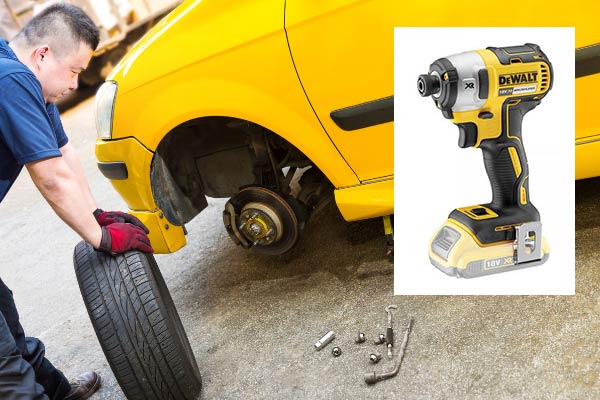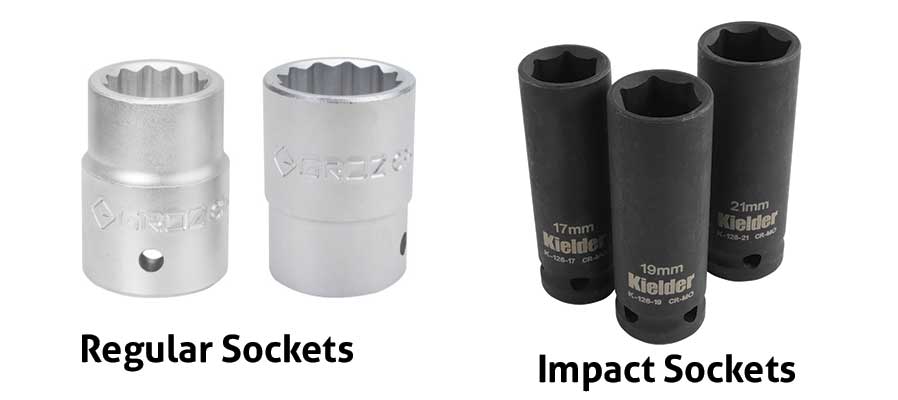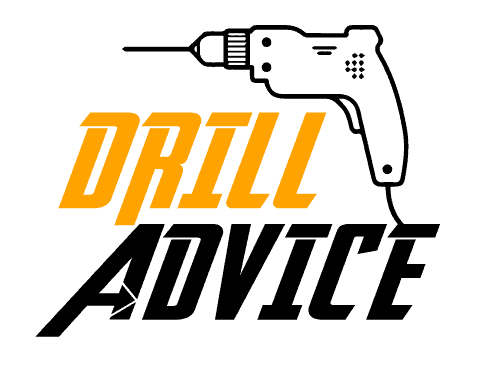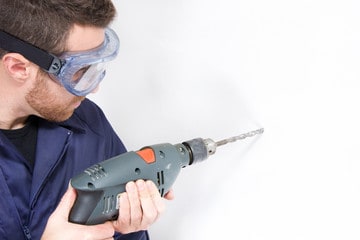Impact drivers are majorly used in carpentry and DIY projects. Moreover, impact drivers are used in the automobile industry to pop out fast or fasten the bolts and nuts in vehicles without tiring out the technicians. The most used automotive task is changing car tires. So let’s see whether an impact driver can be used for automotive works.
Normally, impact drivers can be used for automotive to a certain extent because an impact driver has 500 in-lbs – 1200 in-lbs of torque which is equal to 57Nm – 136Nm. A car tire lug nut requires 95Nm – 160Nm of torque for fasting or removing. So, most impact drivers are not able to produce that much torque for lug nut work.
Remember, impact drivers are not the ideal tool for the automotive industry, yet the portable and compact structure of impact drivers, along with impressive torque, makes them appropriate for a range of automotive-related work, particularly in repairing.
What is the Use of Impact Drivers in Automotive?
An impact driver is used in automotive for various tasks, most commonly for loosening and tightening nuts, bolts, and lug nuts. Impact driver produces 57Nm – 136Nm of torque. This rotational force delivers a strong, sudden rotational force and forward thrust, making it easier to drive screws into tough materials.
It is especially useful in automotive for changing tires, engine repairs, installing car accessories, and other maintenance or assembly tasks. Its compact size and power make it easier to work in tight spaces under the hood of a car. In addition, it is helpful in reducing wrist strain, as the impact action absorbs some of the torque impact, which means you aren’t fighting the tool as much.
What are the Recommended Torque for Lug Nuts?
Before trying to remove a lug nut using an impact driver, go through the following chart. This chart gives an idea about the amount of torque that can be added for a specific size of the lug nut.
| Wheel stud size | Regular range of torque | Number of turns of hardware interaction |
| 7/16 inch | 70 to 80 | 9 |
| ½ inch | 75 to 85 | 8 |
| 9/16 inch | 135 to 145 | 8 |
| 12×1.5 mm | 70-80 | 6.5 |
| 12×1.25 mm | 70-80 | 8 |
| 14×1.5 mm | 85-90 | 7.5 |
| 14×1.25mm | 85-90 | 9 |
What are the Advantages and Disadvantages of Using Impact Driver in Automotive?
The advantages and disadvantages occurs due to power consumption, size, weight, and user experience of using an impact driver.
Advantages of using impact driver in automotive
- High torque output – Impact drivers are great for loosening stubborn bolts and nuts.
- Compact size – Impact drivers are easy to use in tight spaces.
- Efficient – Impact drivers make tasks quicker and less exerting.
- Versatile – Impact drivers can be used for a variety of tasks.
- Reduced strain – Impact drivers absorb much of the torque, protecting your wrist.
- Enhanced control – Impact drivers facilitate precision in driving screws and prevents over-tightening.
Disadvantages of using impact driver in automotive
- Noise-impact drivers are significantly louder than regular drills or drivers.
- Expense – Impact drivers are generally more costly than regular drills/drivers.
- Limited use – Impact drivers are not suitable for delicate tasks or precision drilling.
- Not all have adjustable torque – Impact drivers can over-tightening nuts due to lack of adjustable torque.
- Need for special bits – Impact drivers require hex-shank bits, not regular round-shank drill bits.
- Less Powerful – Impact driver battery life can be limited, especially under heavy use.
How Much Torque Does A Car Tire Need?

Car wheel torque is considered the tightness of the lug nuts calculated in foot-pounds (ft-lbs). foot-pounds are associated with the amount of weight necessary to move an object to a particular expanse. The following chart presents the torque setting of widely used car models.
When we consider the torque for the nut, there are mainly both.
- Break away torque – Required torque to remove the nut
- Fastening torque – The torque needs to tighten the nut
Always, the breakaway torque is higher than the fastening torque. Because a nut can rust or be mechanically tightened with the nut. So it needs higher torque rather than tightening it.
| Car | Model | Torque (Steel) | Torque (Alloy) |
| Audi | All current types | 120NM | 120NM |
| RS 2 | 130NM | 130NM | |
| RS4 (8D), A6/A8/S8 (4E) | 140NM | 140NM | |
| Q3, Q5 | 140NM | 140NM | |
| Q7 | 160NM | 160NM | |
| Aston Martin | Vanquish | – | 130NM |
| Other | – | 100NM | |
| Bentley | All current types | 130NM | 130NM |
| BMW | All current types | 140NM | 140NM |
| 1.3Coupe/Cabrio (E92/93) Z4, X1 | 120NM | 120NM | |
| Ferrari | 348 & Testarossa | – | 100NM |
| 360 Modena | – | 110NM | |
| 456 & All other models | – | 120NM | |
| 550, 575 | – | 135NM | |
| Honda | All current types | 108NM | 108NM |
| Hyundai | All current types | 100NM | 100NM |
| Hummer | – | 180NM | |
| Isuzu | All current types | 118NM | 118NM |
| Jaguar | X-Type | 80NM | 103NM |
| S-Type | – | 128NM | |
| All current types | 125NM | 125NM | |
| Jeep | Commander, Grand Cherokee | 136NM | – |
| All current types | 135NM | – | |
| Kia | Carnival, Carens, Sorento | 100NM | 100NM |
| All current types | 98NM | 98NM | |
| Lamborghini | – | 110NM | |
| Lancia | Y, Delta, Musa | 86NM | 98/100/120 |
| Kappa, Thesis | 98NM | 98NM | |
| Phedra, Zeta | 100NM | 100NM | |
| Thema | 150NM | – | |
| Voyager | 160NM | – | |
| Land Rover | All current types | 140NM | 140NM |
| Defender | 105NM | – | |
| Freelander 2006 -> | 133NM | – | |
| Range Rover Evoque | 133NM | – | |
| Maserati | – | 120NM | |
| Mazda | CX-5, 6, 2013 -> | 128NM | 128NM |
| MX-5 | 98NM | 98NM | |
| Mercedes | A, B, C, CLA, CLS, E, SL, SLS, G | 130 | 130 |
| Benz | S, CL, R, M, GL, GLK | 150 | 150 |
| CLC, SLK | 110 | 110 | |
| Mini | all current types | 140 | 140 |
| Mitsubishi | Pajero, Pajero Sport | 120 | 120 |
| L 200 | 135 | – | |
| all current types | 108 | 108 | |
| Nissan | Pixo, Cube | 85 | – |
| Micra, Tiida, Juke, 370 Z, Murano, X-Trail | 108 | – | |
| Note | 105 | – | |
| Leaf | 112 | – | |
| Qashqai, Pathfinder | 113 | – | |
| Patrol | 133 | – | |
| Vauxhall | Agila | 100 | 100 |
| Mokka, Zafira | 140 | 140 | |
| Peugeot | 206, 307 / CC, 407, 607 | 90 | 90 |
| 4008, 807, Expert | 110 | 110 | |
| 508 | 120 | 120 | |
| all current types | 100 | 100 | |
| Porsche | Cayenne , Macan, Panamera | – | 160 |
| all current types | – | 130 | |
| Renault | Clio, Twingo | 105 | 105 |
| Fluence, Grand Scénic | 130 | 130 | |
| Laguna, Latitude | 160 | 160 | |
| all current types | 110 | 110 | |
| Suzuki | Ignis, Swift, SX 4 | 95 | 95 |
| Jimny, Grand Vitara | 110 | 110 | |
| all current types | 90 | 90 | |
| Toyota | Avenis 2009 | 135 | 135 |
| GT 86, Hilux | 120 | 120 | |
| Land Cruiser | 130 | 130 | |
| all current types | 110 | 110 | |
| Volvo | C 30, S 40, V 40, V 50, C 70 | 110 | 110 |
| S 60, V 70, S 80, XC 60, XC 70, XC 90 | 140 | 140 | |
| VW | Up | 110 | – |
| Tiguan, Sharan 2010 | 140 | 140 | |
| Sharan, T 4 | 170 | 170 | |
| Touareg, T 5, Amarok | 180 | 180 |
Can Impact Wrench Sockets Be Used In Impact Drivers?

One of the fundamental disparities between these impact tools is their collet size. Impact drivers have a ¼-inch hex collet that accepts 1/4-inch hex shank bits.
Many impact wrenches generally use a 1/4″, 3/8″, or 1/2″ square drive to a socket will be connected to. Socket adapters and nut driver bits enable the use of impact wrench sockets in impact drivers. Further, some adapters let your impact wrench accept 1/4-inch driver bits.
Can A 1/4” Inch Impact Driver Remove Lug Nuts?
This depends. Impact drivers with ¼-inch hex drivers are primarily used to strip off smaller nuts, trim screws, and bolts. For larger lug nuts, a ¼-inch square drive.
An impact driver or wrench is the most appropriate choice. The lug nuts of a car can be removed using an impact driver provided the nuts are tightened at the right amount of torque ( 80 to 100 lb-ft) and your impact driver’s output torque is higher than 100 lb-ft.
Read More About – Corded vs Cordless Impact Drivers
Is 300 Ft-Lbs Enough To Remove Lug Nuts?
When examining the above lug nut torque chart, it is obvious that most lug nuts are supposed to be torqued to about 100-120 ft-lbs. Some require less torque; others require more.
If you tighten a lug nut to 300 ft-lbs, you should be able to immediately remove it using a tool that can deliver 300 ft-lbs of torque. 300 ft-lbs will be too much for lug nuts that have been tightened to less than 300 ft-lbs. As time and environmental conditions often require a lot more torque to be used, it will require a torque of more than 300 ft-lbs.

